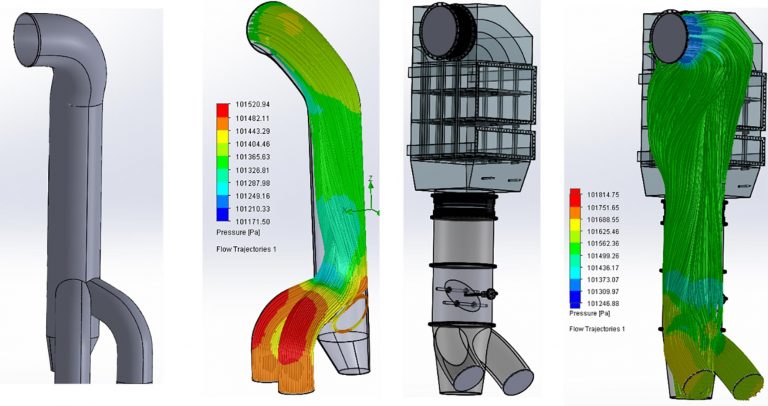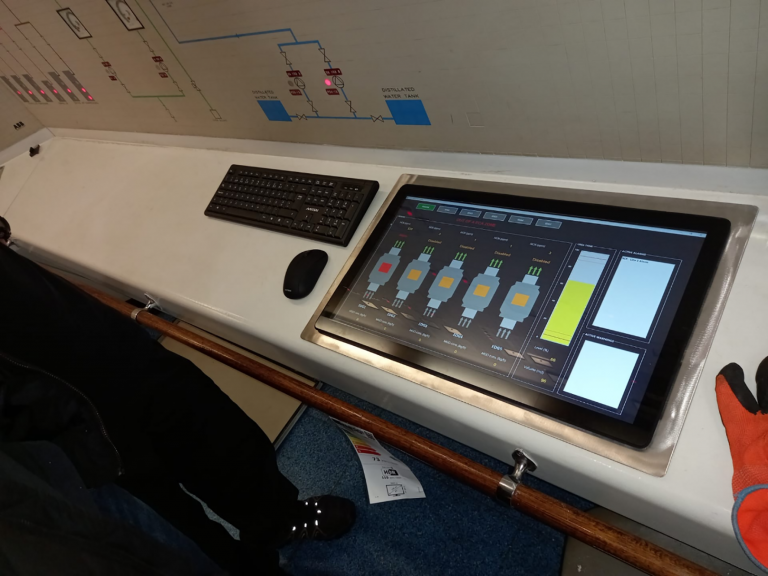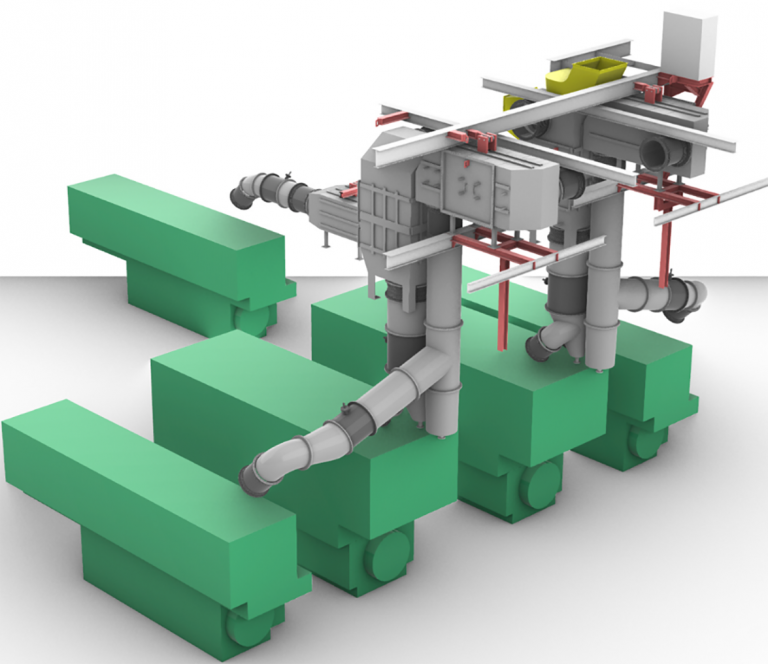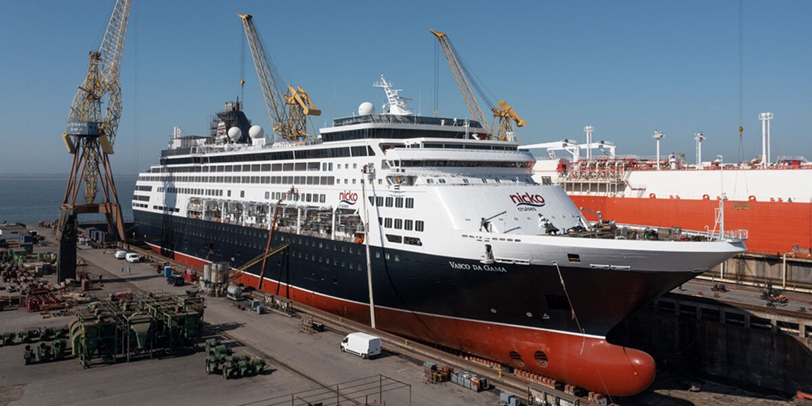Environmental Update of Pre-2000 Vessels: M/V “Vasco da Gama” A First Successful Shipping Circular Economy Example
M/V “Vasco da Gama” is a luxurious 27 years old vessel with a loyal clientele. The actual ship owner “Mystic Ocean”, decided to keep the vessel in service on the most desired destinations, like the Heritage Fjords of Norway and the Baltic, where the most stringent air pollution regulations are in force.
Looking forward, and considering the near future air pollution regulations under MARPOL, namely the NOx emissions and EEXI, it was decided to perform a study on how that can be achieved for the next 10 to 15 years. As a consequence, the vessel received several high tech improvements to become compliant with TIER III NOx, Digitalisation and Sewage for the Baltic Sea operation (MEPC.227(65)), and Slick hull paint. With these improvements a new opportunity for the vessel successful operation around the world is possible. The vessel received a new notation from the class, the EGCS(SCR).
This project is considered a good example of Circular Economy applied to the shipping industry, and a good example to follow. Instead of dismantling a superb cruise vessel-like “Vasco da Gama”, dismantling related emissions, originated by scrapping, (consequent melting of steel) were avoided, along with the waste of a vast quantity of other materials. Also, this project proves that existing vessels are not condemned to be scrapped, but being revamped in all environmental aspects, namely emissions, sewage, energy consumption, and passenger comfort, can compete with newly built vessels on the same grounds, resulting in a more sustainable cruise shipping activity:
- The fuel efficiency increased 6%, therefore accounting for a reduction of CO2 emissions of about 6% too.
- NOx emissions (compliant with TIER III) had a decrease of 82% regarding the original emissions.
- SO2 emissions had a decrease of 81.5 %.
The project was based on extensive marine engineering studies, closely monitored by the class (LR), obtaining the new notation EGCS (SCR).

Figure 1 – Example of exhaust gas back pressure computer optimisation simulations (before and after).
The vessel arrived in Lisbon on December 2020 and at LISNAVE Shipyards on the 1st January 2021, for drydocking and initiation of the project. Immediately, despite COVID19 constraints, the project was initiated “full ahead”. The engine room was Laser scanned and the studies of accesses were initiated while calculations based on the engine exhaust gas flowrates were running in parallel. Once the five independent housings spaces were identified, their housings for the new catalysts were defined, their construction started, and engine room cutting initiated.
Stability calculations for the 5 housings (each of 5 tonnes), and DB urea bunker tank, were running in parallel, with other project activities like new bunkering stations, digitalisation system for performance monitoring using the TecnoVeritas own cloud-based software BOEM.

Figure 2 – Remote monitoring of ship emissions through BOEM cloud platform.
On the 22nd of June, the vessel returned to the water, for sea trials, during 6 days trip from Setubal to Amsterdam.
While catalysts works were in progress, the vessel had three engines overhauled, receiving the components that needed to be replaced according to NOx Code, as well as two new turbochargers, and overhauling the others.
The systems and the project were surveyed and approved by LR, and emissions were tested independently by ECOxy from Norway, for the Norwegian Maritime Authority. ECOxy performed the measurements during the sea trials.
It was found from the viability study, that the payback time is less than one year, provided the pandemic allows.
The present project is a novelty in terms of Circular Economy, and its dimension. The systems installed were capable of achieving NOx values well below the TIER III limit, on the original vessel SULZER ZA40S engines (pre-2000).
All the five catalysers are by themselves unique pieces, their design was made to achieve extremely low NOx emissions while keeping the exhaust gas pressure drop to a minimum, and their operation controlled based on artificial intelligence, so that the five Selective Catalytic Reactors (a partnership between TecnoVeritas and H+H), are continuously optimised in terms of their individual performance to minimise the consumption of urea, and therefore complying with the future ammonia slip regulations, so that constitutes is an innovation.
The operation of the catalysers is optimised by considering the inlet air temperature, the engine load, the fuel quality, and supported by a feedback control loop that dynamically and optimally adjusts the reactors’ operations.

Figure 3 – Extensive 3D project simulation. “Camel through the needle hole.”
Scrapping decisions have been made, mainly based on environmental considerations, namely by making shipowners believe that their ships cannot be environmentally competitive, being instigated by shipbuilding, banks and engine manufacturers.
This project has proven that MARPOL TIER III NOx level of emissions, can be achieved by a 27 years old vessel, at controlled costs, and that their environmental performance can be as good, or even better than many recently built vessels.
In the present project, no EIAPP certificate was issued, although NOx regulations, namely TIER III, were achieved and officially confirmed for the Norwegian Maritime Authority, therefore proofing that EIAPP certificates should also be awarded to vessels equipped with exhaust gas cleaning systems, like M/V “Vasco da Gama”. Therefore, providing evidence that it’s possible for older engines to comply with NOx emission standards. This matter has been responsible for the dismantling of many vessels, that if environmentally revamped could have their operational life extended for some years more.
Scraping and recovery of the materials will originate a huge Carbon Footprint that will take a long time to become nil.
A consortium formed by TecnoVeritas and Lisnave Shipyards is now offering similar turnkey solutions, including the vessel digitalisation and energy optimisation (considering the coming EEXI regulations), therefore making it possible to extend the profitable operation life of many existing vessels, mainly cruise vessels allowing their operation in the most preferred touristic spots, complying with the stricter air pollution regulations (namely TIER III).




